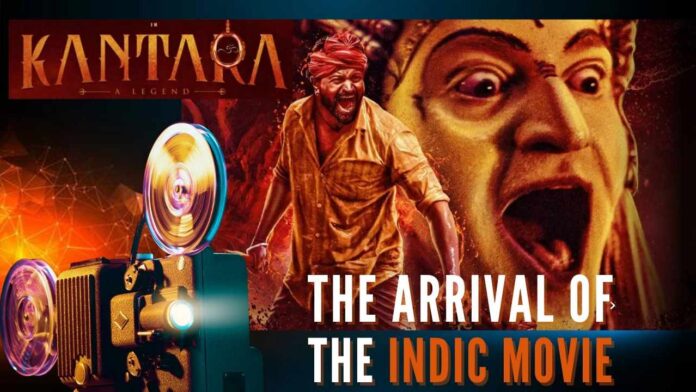
Kantara gives a Divine experience
Much has been said about the movie Kantara – meaning mystical forests. It has been an interesting viewing experience, the climax and the actual storyline with its sublime imagery of the Gods – vana devathas and their protectors in the forest ritual dance of Bhootha kola, building up to the almost surreal enthralling experience.
The storyline is simple and clear, in the 19th century, the local king in the Tulunadu Karnataka coastal region bordering Kerala is promised peace of mind in exchange for the land ownership that the tribals enjoy in the deep forests. The present-day descendant of the king, despite the fact that his father died a bloody death on the steps of a court, again covets the forest lands while pretending to be a friend of the community. The hero, Shiva belongs to a family which performs the traditional divine ritual Bhootha-kola; his father disappears mysteriously in a mystic encirclement in the deep forests. Shiva is a happy-go-lucky person who wins the Kambala annual bull races, who is running away from his mother’s scolding, who enjoys his occasional hunting of wild pigs and his altercation with the forest officials who obstruct him in hunting; occasionally he is haunted by the Varaha-Roopa. He meets and falls in love with forest guard Leela who is arraigned against him in his fight with forest officials. After the death of his brother who leads an austere life worshipping the traditional deities in Bhooth-Kola, the mantle finally falls upon Shiva. When the battle ensues between the deceptive zamindar’s men and the forest community, in that moment of his final denouement, the Daiva `Panjurli’ breathes life into Shiva, the fierce Varaha Roopa is unleashed, and he becomes One with the Deity; continuing his ancestral tradition of protecting the sacred groves, and the community which is embedded in the lap of the forests.
The undercurrent of the story is the eternal battle between man and nature, nature and human greed, between community rights and state control, between development and conservation of forest environment, between ancient cultural practices and `modernity’. All these underlying themes are resolved in the final denouement, where the vice is killed, the wrongdoers are punished, the sacred lands and deities are given protection as `reserve forest’, and the community enjoys its traditional rights and practices.
The movie is resplendent with the imagery of Maha Vishnu as the fiercest Varaha Roopa, and of Mahadeva Shiva including the name of the protagonist and his tree-house Kailash. When the ritualistic Bhootha-Kola is performed, the rhythmic verse `Varaha roopam daiva varishtam, vajradantha dhara raksha kavacham…’ is played up with the sublime imagery of Vishnu’s fierce Avatara, the Varaha Roopa, the wild boar which is a symbol of the lands and forests. The divine `guardian deity’ of the Kshetra depicted in Kantara is the `Panjurli deva’, with `Guliga’ being the Kshetra-palaka. It is interesting that daivas/ prakruti/ bhoothas are almost interchangeable in their symbolic imageries, they are real and robust. The Kannada byline of the movie is `dante kadha’ – the legend of the forests.
Bhootha-Kola is performed in the region between southern Karnataka and northern Kerala in the forest regions. Theiyyam in Kerala is equally popular. Like the various Grama-Devatha traditions and Puranas, the traditions of vana-devatha puranas were prevalent in almost all regions of the nation. Unfortunately many are forgotten as they were branded as empty superstitions, which virtually cut the connection of the Hindus with their sacred traditions. Many hilly-forest regions of the nation including Uttarakhand and Himachal Pradesh – the Kulu Dusshera celebrated recently-are identifying with the dharmic forest traditions depicted in the movie.
The movie touches many cords and scores on many points brilliantly. The beauty of the dharmic sense in the movie is that it’s entirely natural and in the fitness of things, nothing is contrived, the movie flows naturally to its logical end. It evokes the forgotten sense of ancestry and traditions in us, which are subliminal in the recesses of our minds. It touches upon the innate sense of Devas and Devis in all of us; the concept of divine kshetras-the sacred groves, which are meant to be out of bounds for human exploitation and greed; the harmonious relationship between humans, animals, birds, rivers, and trees; and the seamless bond between the divine protectors and humans, among other things. The movie depicts the oneness of humans, nature, and divinity; and organically belongs to Indic culture and traditions, its many art forms, and its dharmic way of life. The oft-repeated sentence that the local is universal indeed comes true here, we feel in the midst of the Divine. The flesh and blood of the movie come from the soil and soul of the nation. It is time to retrieve the Puranas of grama-devathas, vana-devathas, kula-devathas of this ancient land for the Hindu resurgence.
As a Telugu viewer, the Telugu version, unfortunately, doesn’t translate the pious verses of the Bhooth-kola into Telugu. One can’t help but feel the contrast between the Telugu blockbuster `Pushpa’, in which the hero is a red-sandalwood smuggler and the hero of Kantara who is not only a protector of the sacred forests but also a practitioner of the ancient traditions of nature and divinity. Namaskars to the innate dharmic sense of Rishabh Shetty, the producer, director, and hero of Kantara.
Kantara truly denotes the advent of the Indic movie. Dharmo Rakshati Rakshitaha.
Note:
1. Text in Blue points to additional data on the topic.
2. The views expressed here are those of the author and do not necessarily represent or reflect the views of PGurus.
PGurus is now on Telegram. Click here to join our channel and stay updated with all the latest news and views
For all the latest updates, download PGurus App.











This film is outstanding.